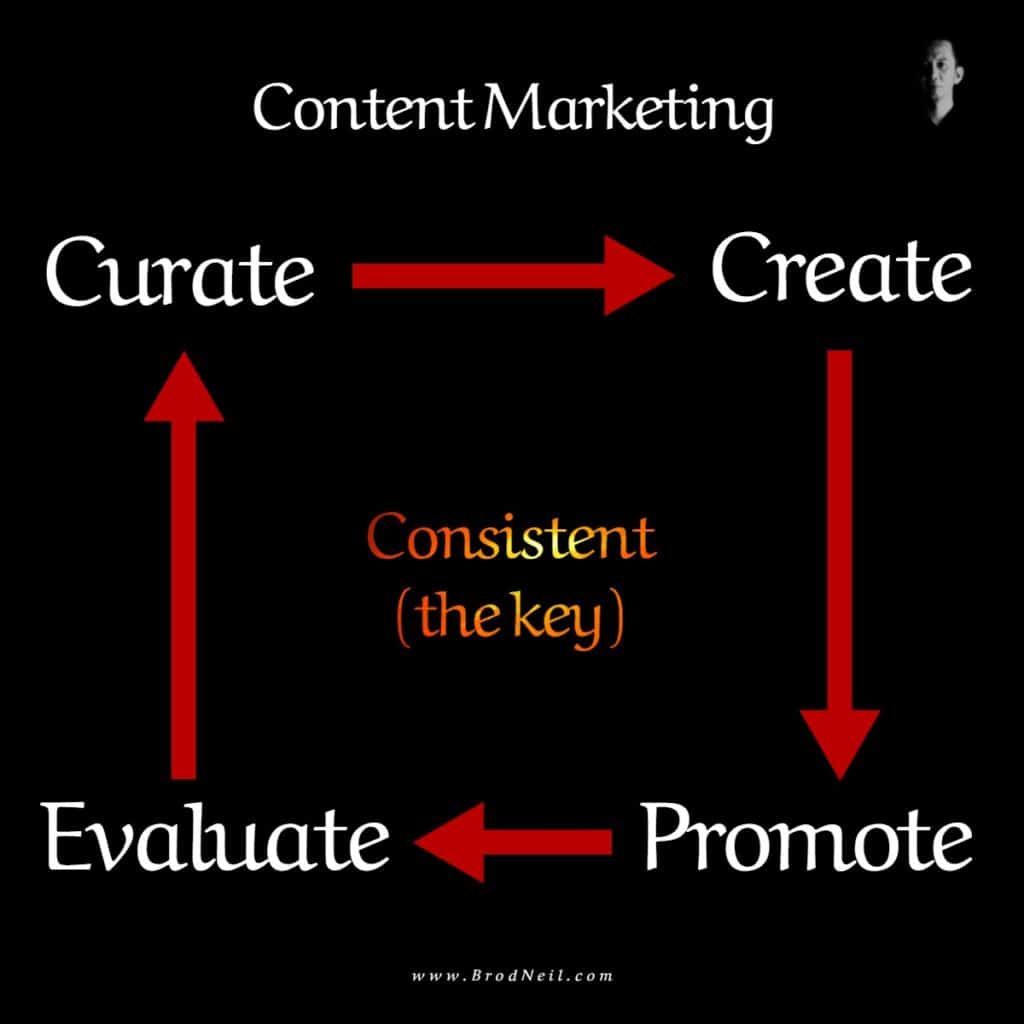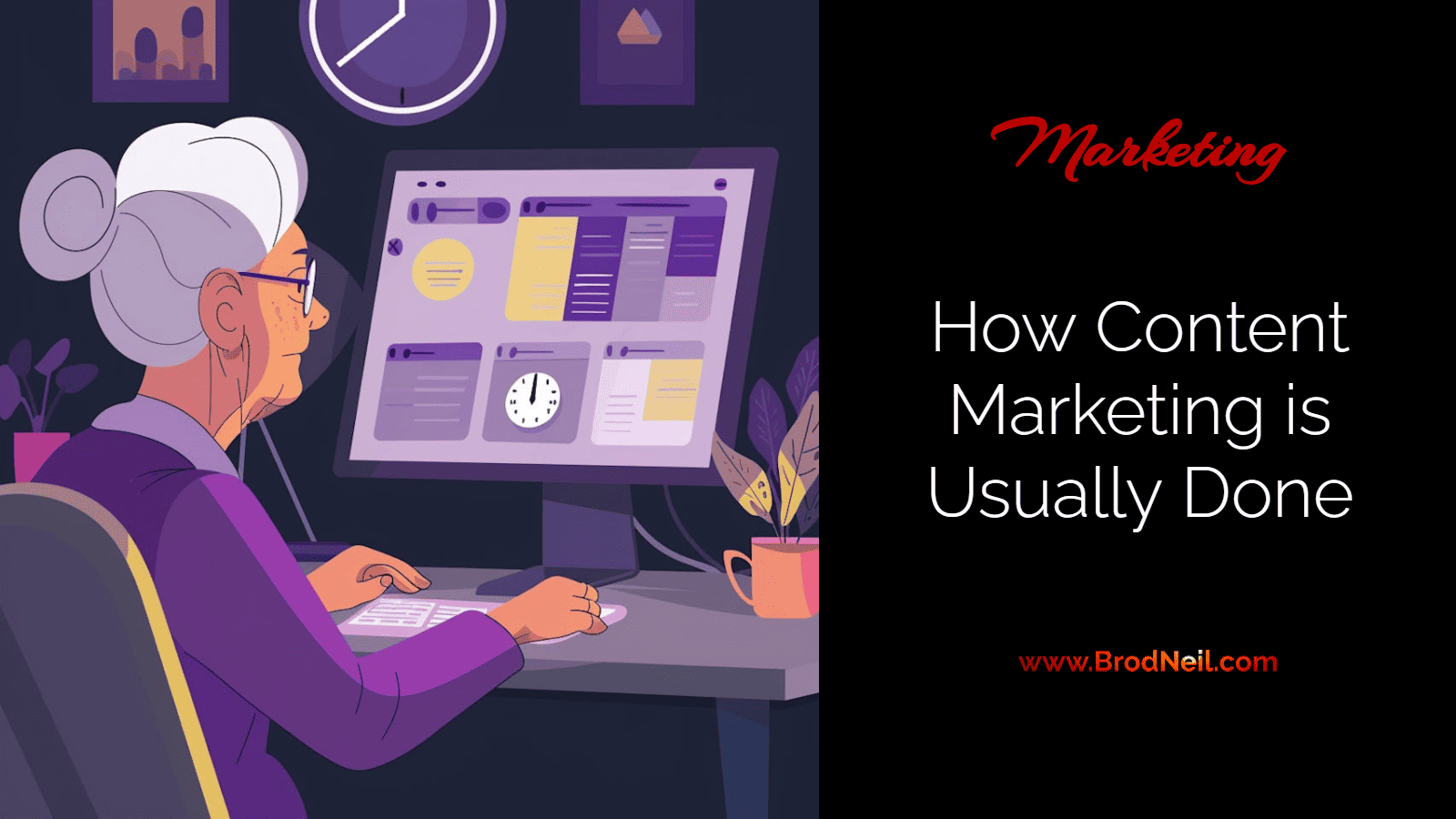Last Updated: 1 month ago by BrodNeil
If you want to increase traffic in your website, you need a strategy that will attract your target audience and keep them engaged.
You need content marketing.
By consistently creating and sharing relevant content, you can drive your target audience to your website and hopefully turn this traffic into sales.
But there is a challenge. You just don’t create any content and promote them anywhere and anytime. There has to be a way to get things done.

The content marketing process
Content marketing usually involves the following process, but you can always modify it:
- Identify your content marketing goals.
- Know your target audience and their interests.
- Plan how to make your content relevant and unique.
- Create valuable and optimized content.
- Promote content in different channels (blogs, social media, email, etc.).
- Generate and analyze reports.
- Go back to planning.
- See what can be done to improve results.
- Identify contents that are generating the most responses or sales so they may be amplified.
- Incorporate new ideas.
Here is a simple diagram to show you how content marketing strategy is usually done.

Let’s dive into the details.
Identify your content marketing goals
Your marketing goals determine what outcomes you want for your content marketing strategy.
They serve as the foundation of your strategy and your guide all throughout the process. With clear goals, you will have a way to assess your content marketing process and your results.
Your goals must be clear, specific, and aligned with the main marketing goals of your company. To guide you, here are some examples of content marketing goals shared by Content Marketing:
- Brand awareness – being discovered by your target audience;
- Audience engagement – earning the interest of readers and turning them into subscribers;
- Lead generation – knowing readers who can become prospective customers;
- Customer trust and loyalty – retaining customers through customer satisfaction and positive brand image; and
- Sales and profitability – getting more sales conversions; minimizing costs; and finding new ways to earn.
Know your target audience and their interests
Do you know your target audience? The target for your content should be the people who could potentially become your customers.
So who are they?
They are the ones who may be directly interested in your products or services or related to what you are offering. For example, if you are selling gardening tools, your target audience will not just include gardeners or landscapers, but also homeowners, plant lovers, green living advocates, and even environmentalists.
Once you have identified your target audience, you need to know their interests. Learning about their interests will help you develop the specific topics for content creation. It will also help you develop keywords you can use so that your content will show up in searches.
Audience Targeting through Content Marketing
Your customers are your lifeblood. How well you target and communicate with them can make or break your business. The right audience targeting solution will save you time and money while helping you find and keep the customers that are most likely to buy from you.
Audience targeting is an essential part of marketing. Understanding your target audience can create a marketing strategy that resonates with them and drives results. There are a number of factors to consider when targeting an audience, including demographics, psychographics, and behaviors.
Demographics include factors such as age, sex, income, and education level. Psychographics include things like interests, values, and lifestyle. Behaviors refer to how someone uses products or services. All of these factors can help you better understand your target audience and create messaging that speaks to them.
Once you understand your target audience better, you can begin to tailor your content and marketing efforts specifically for them. This will help you connect with your audience in a more meaningful way and boost conversions.
What is audience targeting?
Audience targeting is a marketing technique that allows businesses to target specific groups of consumers with their advertising and marketing efforts. By understanding the characteristics of each group, businesses can create ads and content that is most likely to appeal to them. This can be a valuable tool for targeting customers who are more likely to purchase a product or service, as well as creating more effective campaigns overall.
Types of Audience Targeting: Demographic, Geographic, Psychographic
Different businesses use different methods to target their audiences. The three most common types of audience targeting are demographic, geographic, and psychographic.
Demographic targeting involves using information about the age, gender, income, and education of the audience to identify who the ad is meant to reach. This type of targeting is often used by businesses that sell products or services to a specific group of people.
Geographic targeting involves using information about where the audience lives or where they are likely to travel. This type of targeting is often used by businesses that want to advertise their products or services in a specific area.
Psychographic targeting involves using information about the interests and attitudes of the audience. This type of targeting is often used by businesses that want to target people with specific lifestyles or values.
How to Choose the Right Type of Audience Targeting: Consider your business goals
When starting a business, it is important to consider your business goals and the target audience you want to reach. There are many different types of audience targeting, and the right one for your business will depend on your goals. Some common types of audience targeting include geographic targeting, demographic targeting, and behavioral targeting.
Geographic targeting involves focusing on a specific area or region. This can be done by choosing a certain country, state, or even city to target.
Demographic targeting focuses on characteristics such as age, gender, income level, or education level.
Behavioral targeting targets people based on their past behavior online. This can include things like what websites they have visited, what products they have looked at online, or what type of content they have shared on social media.
Implementing Audience Targeting: Online and Offline Strategies
Audience targeting is the process of understanding and predicting the behavior of a target audience in order to create a communication strategy that resonates with them. The goal of audience targeting is to identify the most relevant audience for a campaign and then deliver marketing messages that are most likely to persuade them to act. There are two main ways to target an audience: online and offline.
Online audience targeting involves using digital technologies to reach potential customers. This can be done by creating targeted ads on websites, social media platforms, or through email marketing. Digital technologies make it easy to track how people are interacting with your content, so you can make sure your messages are reaching the right people.
Offline audience targeting involves reaching potential customers through traditional methods such as TV, radio, or print advertising. It can also include personal interactions such as face-to-face meetings or telephone calls.
Why you need great content to attract and engage customers online
In an age where customers are increasingly disconnected from physical stores and shopping experiences, businesses must create compelling content to attract and engage customers online. Great content is not only informative and entertaining, but it also provides a sense of connection with the company or product. This is why great writing is so important in online marketing; by providing quality content, businesses can connect with their target audience and create loyal followers.
Plan how to make your content relevant and unique.
Since content creation is made for your target audience, you should aim to provide them with relevant content. Relevant content simply means the content they are interested in. It contains the information they need and want. Relevant content is something that your audience will really read about.
What if everyone else in your industry is doing the same? How do you make your content stand out?
Assuming you are going to make a really informative and relevant content that will be free from grammatical errors, your content may still get less attention if it is not unique enough. If you will provide the same great information as your competitors, your content can stand out with the following tips:
- Create a relevant and striking headline. Make sure your headline is interesting and it reflects what the post is really all about.
- Make use of original stories. No one wants to read content that one can find in other sources.
- Use images, infographics, videos, and other visuals. These visuals will make it easier for your audience to understand the information you are communicating.
- Utilize proper headings, subheadings, and lists. These will make your post easier to read and follow.
- Get rid of long paragraphs. They are obviously boring to read.
- Include overviews or key takeaways for longer posts. Some readers skim over the post to see if they will be getting the information they really need before reading the entire article, so make sure you make it easier for them to see what you have.
Create valuable and optimized content
This is now the step that you create content that is relevant, unique, and of excellent quality. Part of content creation is also making sure you have a Search Engine Optimized content. An optimized content is one that has the capacity to reach its target audience as widely as possible. You can optimize your content by using keywords, inserting relevant links, as well as adding tags and meta tags.
Promote content in different channels
Once you have already created and posted valuable and optimized content in your blog, you should now be ready to promote these content in different channels. These channels include the following:
- Social media
- Email campaign
- Online communities like QandA sites
- Paid media (including social media)
- Own blog or website (through feature posts or internal linking from a related blog post)
- Other websites and blogs (through link outreach, guest blogging, etc.)
Generate and analyze reports
Promoting your content is not the end of your content marketing strategy. It is important to know how your content is performing against other content and other websites on the Internet.
Here are some metrics you need to look into:
Go back to planning
Once you have generated and analyzed applicable reports, it’s time to go back to planning. In this stage you do not need to start from scratch or go back to square one. Here’s what you can do:
- See what can be done to improve results (especially with content creation and promotion);
- Identify contents that are generating the most responses or sales so they may be amplified; and
- Incorporate new ideas.
The content marketing strategy is a cycle. It does not just follow a straight-line process, but a cycle that allows you to improve your tactics and become more effective over time.
Deliverables
When it comes to content marketing, you just don’t create any content and publish them when you have the time. We have to remember that content marketing involves “making and sharing relevant content consistently”.
“Relevant content” means posts that interest your target audience. These are valuable posts that are informative, that answers their questions, and that pays attention to the needs and wants of the target audience. Being able to provide relevant content will help you connect and build productive relationships with your audience by giving value to what they are reading and learning from you.
“Consistently making and sharing” means implementing a schedule for your posts. Part of your planning should include the following:
- the number of deliverables or posts (pillar posts and blog posts) per month or per week
- when to create these posts;
- when to share the posts;
- Where will they be shared (channels); and
- who will be in charge.
All these have to be consistent in order to be effective.


